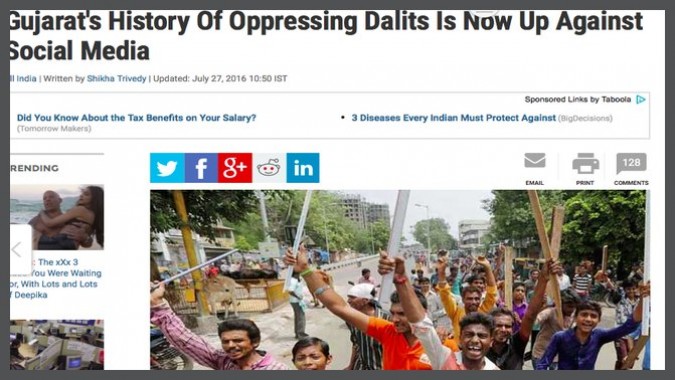Social media helps Una dalits remain uncowed
Some 20 kilometres from Gandhinagar, two middle-aged men stand in an old hall full of women, also mostly middle-aged. The room is filled with utter seriousness and you can see the resolve in the eyes of the women. The men start reading the pledge while raising their right hand and the ladies follow.
“Neither me nor my family member will lift any dead carcasses hereafter.” The pledge ends with Jai Bhim, a salutation to Dr. Ambedkar. The pledge is not only administered but also filmed by dalit volunteers, probably for wider circulation later. The video was shared on Facebook and YouTube on July 24th.
The pledge was part of the organized protest that erupted across Gujarat following four dalits being mercilessly beaten for skinning a dead cow in Una, Gir Somnath district. And it all started with another video shared on social media on 11th July, this time by the perpetrators of the crime. In this horrific atrocity, the videotaping was done by the Gau Rakshaks or Cow Vigilantes themselves to show their ‘bravery’ and to warn others trying to harm their holy cow.
This turned out to have the opposite effect. Instead of terrorizing dalits, the video of the crime united them. Local dalit leaders used this video to spread the word and organized state-wide protests. Gujarat Chief Secretary G. R. Aloria, talking to the Indian Express, conceded that the video uploaded on social media by the accused helped the protestors organize more dalits and helped the dalit victims of Una to assert themselves.
From 11th July to 18th July when Mayawati raised this atrocity in the Upper House, dalits were using social media to do what the mainstream media thus far had not - circulate the Una crime. Some social activists from Navsarjan, a large dalit organization in Gujarat, who were part of a huge rally in Surendranagar used WhatsApp, and Facebook to mobilize dalits for their 18th July rally.
A unique and revolutionary form of protest was used in the rally. Dalits brought cow carcasses to the Surendranagar collectorate and dumped them on the premises. Activists filmed dalits throwing the carcass down while shouting ‘Tumhari mata hai, tum sambhalo’ (It is your mother, you take care of it). All the communication involved in arranging for the carcasses to reach the spot was done through WhatsApp and Facebook. One volunteer, Mr Parmar, has given an interview to Scroll.in on this.
Dalit protest marches usually rely on pamphlets or walls that are painted in blue but with many dalits having mobiles with WhatsApp, connecting quickly has become easier. Without this mobilizing tool, a 1,500-strong protest with carcasses would not have been possible. Secondly, the pledge is videotaped so that others can see, share, and distribute.
Professor Vivek Kumar, sociologist and JNU professor, while talking to online news portal National Dasktak, said that Gujarat’s dalits should be saluted for taking this extraordinary way of protesting by throwing carcasses outside the collectorate’s office. He added that it was a sign of a new assertion which was commendable.
The mainstream media appears to have picked up the Una incident only after 18th July, the day of the Surendranagar protest and Mayawati’s outburst in the Rajya Sabha. Hours later, a new video by BJP vice president Dayashankar Singh abusing Mayawati using choice expletives changed the headlines of the mainstream media forever. Was this a coincidence or part of a wider plan?
Dilip Mandal, formerly managing editor of India Today (Hindi), wrote on Facebook that the Una incident and dalit protests had become a huge embarrassment for the ruling party, especially since the BJP and RSS had advocated cow politics as recently as the Bihar assembly elections.
As the mainstream media shifted focus from Gujarat to Swati Singh, the dalit mass agitation in Gujarat spread across the state. Perhaps for the first time, dalits were using social media effectively to organize and protest on such a large scale in the state. The pledge not to handle dead animals took the protest to the next level. Living as they do, hand to mouth, dalits understand that giving up this age-old profession of skinning cows will cost them dearly, but they were willing to do it to gain self-respect and to secure future generations against assaults from cow protection goons.
The Gujarat protest also threw up contrasts between Dr. Ambedkar and Gandhi. Even in Gandhi’s home state, it is Dr. Ambedkar whose picture and slogans formed the core of the agitation, not Gandhi’s. The dalits of Gujarat, along with dalits in the rest of the country, seem to have preferred the revolutionary Ambedkar (who advocated the annihilation of caste) as a role model over Gandhi, who supported it all his life.







